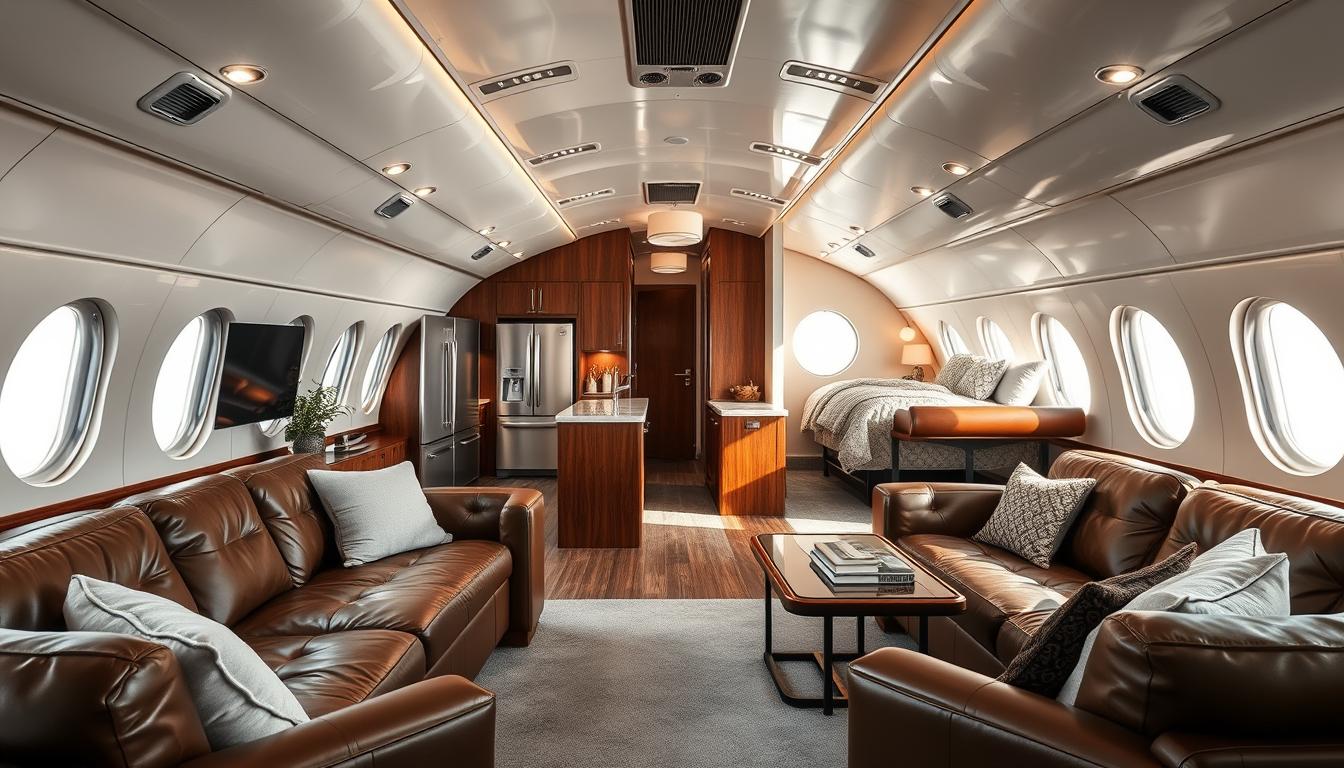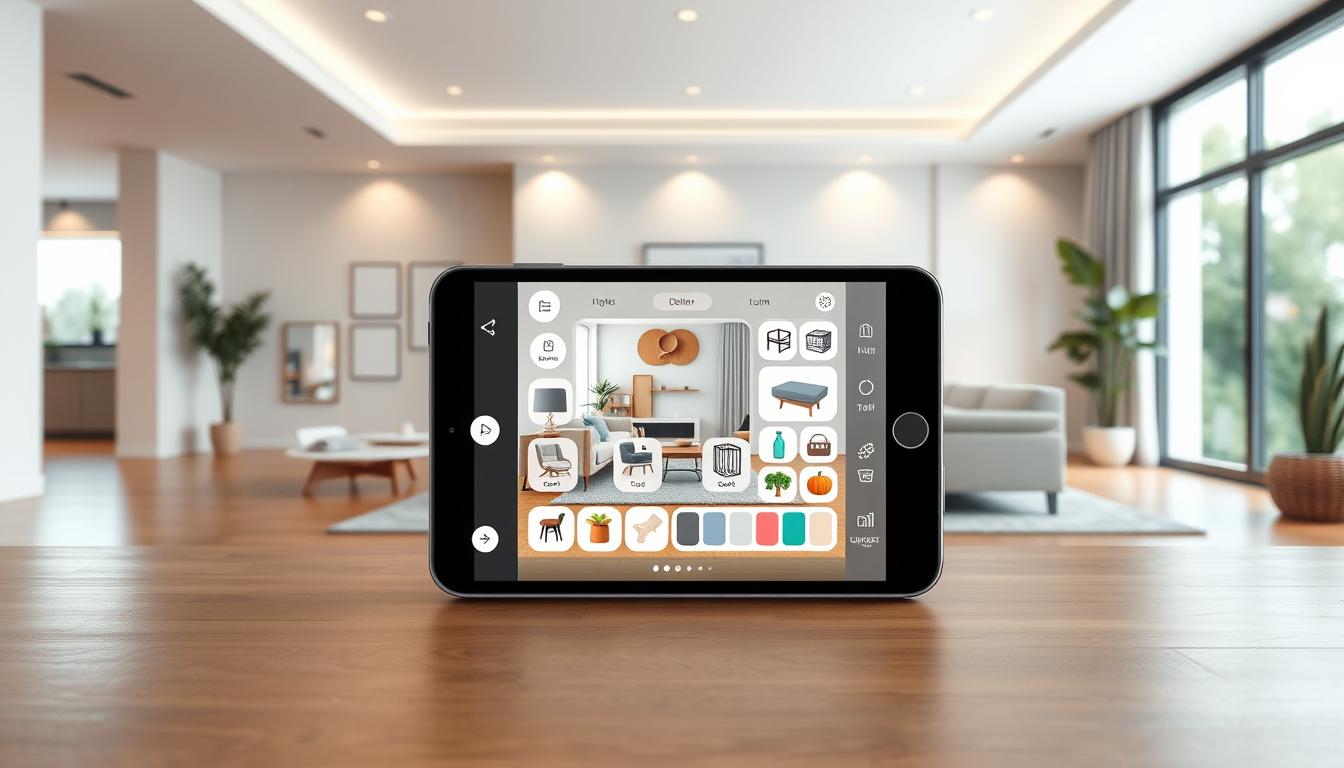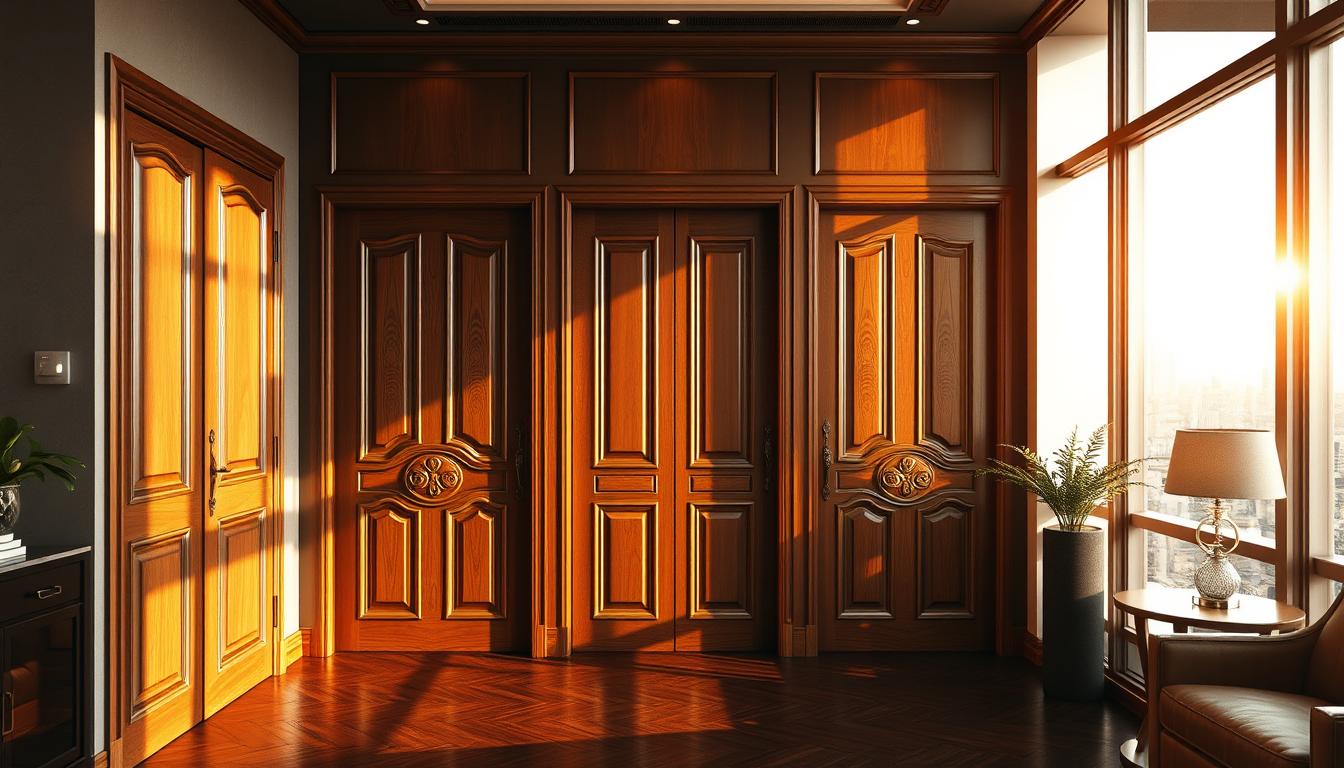Imagine stepping into a luxuriously designed space that was once a mode of transportation soaring through the skies. Our team took on the unique challenge of converting an airplane into a functional and stylish living area. We pushed the boundaries of creativity and innovation.
The result is a breathtaking airplane home interior that combines the comforts of a home with the nostalgic charm of aviation history. In this article, we’ll take you through our journey. We’ll highlight the key decisions and creative solutions that made this project a success.
Key Takeaways
- Transforming an airplane into a living space requires innovative design and problem-solving.
- The process involves careful planning, from conceptualization to completion.
- A unique airplane home interior can be both stylish and functional.
- Creativity and flexibility are key to overcoming the challenges of such a project.
- The end result is a one-of-a-kind living space that combines comfort and character.
Our Inspiration for the Airplane Home Project
We were inspired to turn an airplane into a home. We love unique living spaces and aviation decor. This project let us mix our love for aviation with creative interior design.
The Vision Behind the Transformation
We wanted to make a special living space. It had to show our love for aviation and be stylish and comfy. We aimed to use aircraft-inspired decor in every part of the design.
To do this, we highlighted the airplane’s original features. We adapted them for a modern home. This needed careful planning and creativity to be both useful and beautiful.
How We Found the Airplane
Finding the right airplane was a big challenge but fun. We looked in aviation salvage yards and online until we found the perfect one.
We found a retired aircraft that was well-kept and had many original parts. We saw its potential as a beautiful home and bought it.
The Initial Challenges We Faced
After buying the airplane, we faced several challenges. We had to make sure the aircraft was safe and met local building codes.
We solved these problems by teaming up with aviation and construction experts. Together, we planned how to safely turn the airplane into a home.
| Challenge | Solution |
|---|---|
| Structural Integrity | Consulted with aviation engineers to assess and reinforce the aircraft’s structure. |
| Compliance with Building Codes | Worked with local authorities to ensure the conversion met all necessary regulations. |
| Interior Design | Selected materials and furnishings that were both stylish and functional, incorporating aviation-themed elements. |
Planning the Layout of Our Unique Space
Starting our airplane home project was exciting but challenging. We had to make a layout that was both functional and stylish. The plane’s original design offered both chances and obstacles that needed careful thought.
Designing Functional Areas
We aimed to create different areas in the airplane home while keeping its original charm. We identified zones like a living area, kitchen, and bedrooms. Airplane themed furniture was key, as we picked items that fit the space and matched the plane’s unique look.
The sofa for the living area was custom-made for the plane’s curved walls. It saved space without losing comfort. The dining table was also designed to be small but useful, working as both a dining spot and a workspace.
Maximizing Natural Light
One big plus of an airplane home is its many windows, bringing in lots of natural light. We made sure to keep these windows clear to let in as much light as possible. This made the space feel bigger and showcased the plane’s views.
To boost the natural light, we used light colors on walls and ceilings. This helped reflect light and made the space feel brighter and more welcoming.
Balancing Style with Comfort
Designing our airplane home was all about finding a balance between style and comfort. We wanted it to look great but also be a cozy place to live. So, we chose materials and furniture that were both stylish and practical.
We added soft textiles and ergonomic furniture for comfort. At the same time, we picked decor that showed off the plane’s history and character. This mix of style and function made our airplane home a special place to live.
Choosing the Right Materials for Interior Design
The choice of materials was key in our airplane home design. We aimed for style, sustainability, and durability.
Sustainable Options We Considered
We focused on sustainable materials. We chose reclaimed wood for floors and walls. It’s eco-friendly and adds history.
We also picked low-VOC paints for better air quality. For more on sustainable design, see our guide on stylish spaces.
The Importance of Durable Materials
Durability was crucial for our home. We picked materials that last and look good. For example, durable leather for upholstery is stylish and easy to care for.
Incorporating Aviation-themed Decor
We added aviation-themed decor to our home. We used vintage aircraft parts and sky-inspired colors. This theme ties our home together.
Using elements like vintage propellers and aviation maps made our home special. The right materials made our airplane home unique.
Transforming the Cockpit into a Living Area
We were excited to turn the cockpit into a cozy living area. It was a chance to mix our love for flying with home comforts. This project was both a challenge and an opportunity.
Creating a Cozy Atmosphere
To make the cockpit cozy, we picked soft colors and plush textures. These choices made the space feel like a warm hug. Now, it’s the heart of our home.
Furniture Selection and Arrangement
Choosing furniture for the cockpit was tricky. We wanted it to be both stylish and functional. We picked a sectional sofa that fits the cockpit’s shape perfectly.
The sofa creates a cozy spot. It’s great for family time or relaxing alone. The furniture layout encourages chatting and unwinding.
Enhancing the View with Windows
The cockpit’s windows let us enjoy the outdoors. We kept them clear to let in lots of natural light. This makes the room feel bigger and connects us to nature.
Turning the cockpit into a living area was a success. It shows our love for flying and our style. Our home is now a beautiful story of pilot home decor and creativity.
Designing the Airplane Kitchen Space
We turned the airplane’s small space into a full kitchen. We mixed creativity with practicality. Our goal was to make a compact kitchen that was both stylish and useful.
Features of Our Compact Kitchen
The kitchen was made for efficiency and comfort. We chose a compact cooking range and a microwave to save room. The countertops were made from strong, light materials for easy use and upkeep.
Innovative Storage Solutions
Storage was key in our kitchen design. We used retractable cabinets and pull-out drawers to use space well. This helped us store utensils, cookware, and food efficiently.
| Storage Solution | Description | Benefit |
|---|---|---|
| Retractable Cabinets | Cabinets that slide into the wall | Saves floor space |
| Pull-out Drawers | Drawers that pull out for easy access | Enhances accessibility |
| Overhead Racks | Racks above the countertops | Additional storage for infrequently used items |
Appliance Choices That Fit
Picking the right appliances was important for our kitchen. We chose compact appliances that were both small and energy-saving. This included a small refrigerator and a dishwasher for smaller loads.
By planning the kitchen layout well, picking the right materials, and choosing the best appliances, we made a kitchen that’s both functional and cozy in the airplane.
Developing a Relaxation Zone
We turned the airplane into a cozy home, focusing on a relaxation zone. This area was designed to be a calm escape from daily stress.
We aimed to make this space feel calming and welcoming. It was our own retreat in the airplane cabin. To do this, we used several design strategies.
Embracing Minimalism in Decor
We chose minimalism for our decor. Clutter can make a small space feel tight and stressful. So, we picked a few key items to keep things simple and open.
Minimalist decor let us focus on the airplane’s unique features. It also made cleaning and upkeep easier, adding to the calm feel.
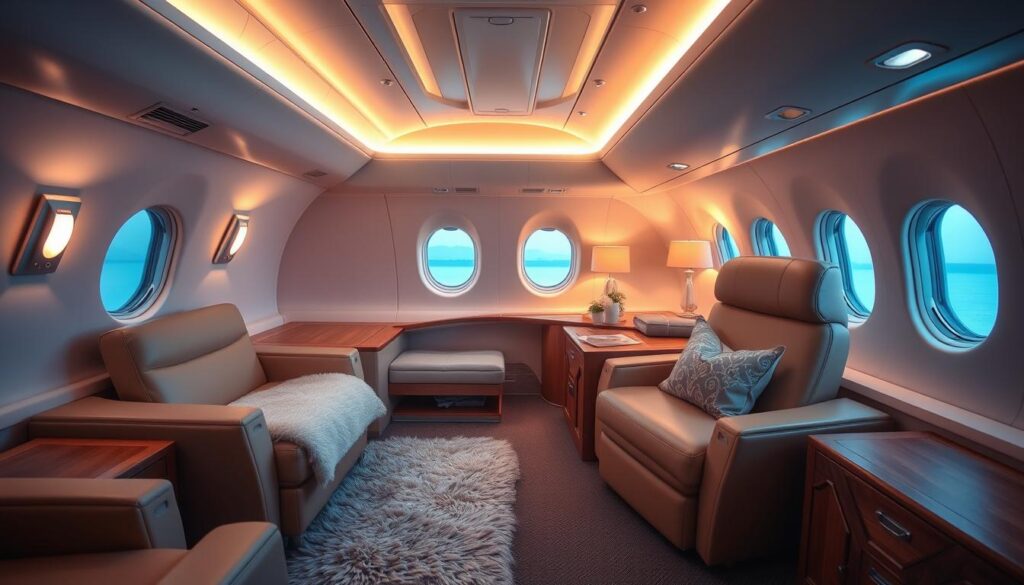
Harmonizing Colors and Textures
Choosing the right colors and textures was key for a relaxing vibe. We picked calming colors like blue and green, evoking the sky and earth.
We mixed different textures, like leather and wood, to add depth and coziness. This mix made our space feel warm and inviting.
| Color | Texture | Effect |
|---|---|---|
| Soft Blues | Leather | Calming |
| Earth Tones | Wood | Warm |
| Muted Greens | Fabric | Soothing |
Incorporating Nature into Our Space
We chose to add nature to our airplane home to enhance its relaxing feel. We included plants to purify the air and bring the outdoors in.
Natural elements like a stone wall and a green wall strengthened our connection to nature. These features brought calm and well-being, making our home a sanctuary.
With careful design, we created a peaceful zone in our airplane home. It’s perfect for relaxing and rejuvenating.
Customizing the Bedrooms for Comfort
We aimed to make our bedrooms cozy and practical in our airplane design. As fans of aviation, we wanted our bedrooms to show our love for flight. At the same time, we focused on comfort and function.
Ideas for Airplane-themed Bedrooms
We looked to aviation for inspiration in our bedroom designs. Some ideas we explored included:
- Using vintage airplane models as decorative pieces
- Incorporating a color scheme reminiscent of the sky and clouds
- Designing bed frames that resemble airplane wings
These ideas helped make the bedrooms feel like part of the airplane.
Space-Saving Solutions for Furniture
Given the airplane’s layout, we had to think outside the box for furniture. We chose:
- Compact beds with built-in storage
- Murphy beds to save floor space
- Multi-functional furniture, like a dresser that’s also a desk
These choices helped keep the bedrooms tidy and still comfortable.
Ensuring Privacy Within The Layout
To keep bedrooms private, we used several tactics:
- Installing soundproofing to block out airplane noise
- Using sliding doors and curtains for separation
- Designing the layout to offer a secluded feel, away from busy areas
These steps helped us create a quiet space in our airplane home.
Integrating Technology into Our Airplane Home
We turned an airplane into a home, focusing on technology to make it better. We wanted a space that was unique and had all the modern comforts.
Smart Home Features We Installed
We added smart home features to make our airplane home cozy and easy to use. Some key features include:
- Automated Lighting: A smart lighting system that changes with the day and light.
- Temperature Control: A smart thermostat keeps the temperature right, saving energy.
- Security System: We set up a security system with cameras and sensors for safety.
Ensuring Wi-Fi Connectivity Everywhere
We made sure our airplane home had strong Wi-Fi everywhere. We did this by:
- Putting in a reliable router.
- Using Wi-Fi extenders for full coverage.
- Securing our network with the latest encryption.
This setup lets us stay connected for work or fun without any hassle.
Energy Efficiency Considerations
We thought a lot about saving energy in our tech setup. We focused on:
- Efficient Appliances: Replacing old ones with new, energy-saving models.
- Smart Power Strips: Using them to cut down on standby power.
- LED Lighting: Choosing LED lights for their energy-saving benefits.
These choices helped us lower our energy use while enjoying modern comforts.
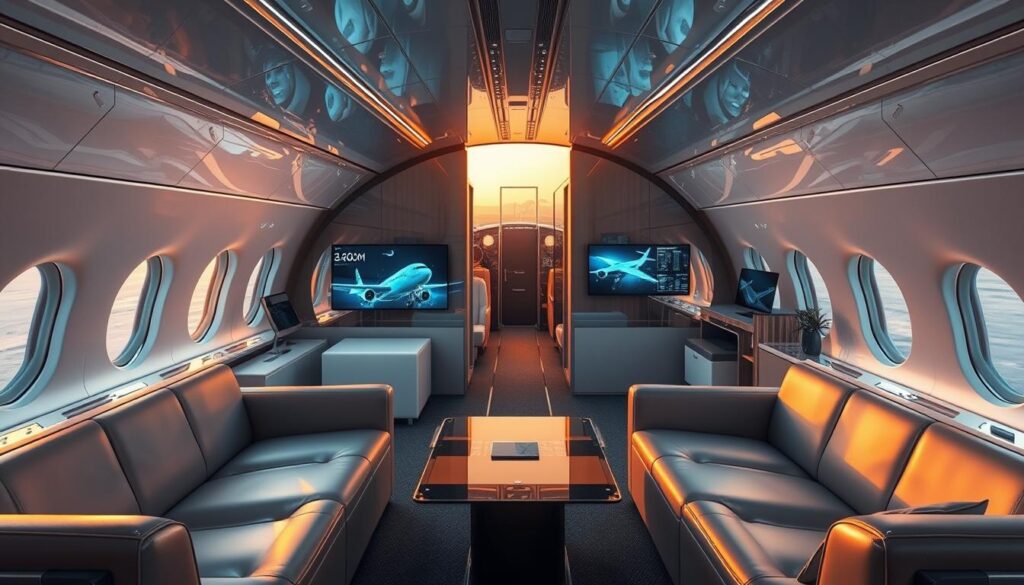
Our journey with tech in our airplane home shows it’s possible to have style and function. It captures the essence of pilot home decor and aviation-themed interior design.
Highlighting Unique Architectural Features
Our airplane home is a marvel of creative transformation. It showcases unique architectural features that blend aviation heritage with modern living. The airplane’s original elements played a big role in shaping our home’s character.
Retaining Original Airplane Elements
We made a big decision to keep as many original airplane elements as we could. This preserved the aircraft’s history and added authenticity to our home. For example, the original cockpit controls are now a unique decorative feature in our living room.
We also kept the airplane’s original windows. They now provide a lot of natural light and offer a unique view. Keeping these elements required careful planning and collaboration with experts in aircraft restoration.
Creative Use of Space
Turning the airplane’s interior into a functional living space needed innovative thinking. We had to make the most of the space while keeping the layout comfortable and practical. We used multi-functional furniture that serves more than one purpose.
- A storage ottoman that doubles as a coffee table
- A murphy bed that allows the bedroom to be used for other purposes during the day
- A kitchenette that’s compact yet fully equipped
These solutions saved space and added to the home’s aesthetic. They helped keep the environment clean and uncluttered.
Focal Points That Tell a Story
Every home has its focal points, and ours are deeply connected to its aviation heritage. We’ve curated aviation-themed decor and memorabilia. They add to the home’s character and tell its history.
“The art of decorating is not about creating a perfect, cookie-cutter space; it’s about crafting an environment that reflects your personality and tells your story.”
Some of the focal points include a vintage pilot’s clock, original aircraft panels repurposed as wall art, and a collection of vintage aviation photographs. These elements create a narrative that celebrates the airplane’s past while embracing its new life as our home.
| Focal Point | Description | Significance |
|---|---|---|
| Vintage Pilot’s Clock | A restored clock from the 1950s, originally used in aircraft cockpits. | Symbolizes the rich aviation history and adds a touch of nostalgia. |
| Aircraft Panels | Original panels repurposed as decorative wall elements. | Preserves the aircraft’s original material and serves as a conversation piece. |
| Aviation Photographs | A collection of black and white photographs depicting historical aviation moments. | Enhances the aviation theme and adds a layer of storytelling to the decor. |
By highlighting these unique architectural features, we’ve created a home that’s functional, comfortable, and rich in character and history. Our airplane home shows the beauty of blending past and present through creative transformation.
Reflecting on the Overall Experience
Turning an airplane into a home has been a thrilling adventure. It has shown us the power of creativity and innovation in airplane home design. As fans of aviation, we’ve always dreamed of making aircraft into homes. This idea is a big part of aviation enthusiast home styling.
Key Takeaways from the Project
We’ve learned to mix function with style in our design. Every part of the airplane home must work well and look good. We’ve also seen how important sustainable materials and energy-saving designs are.
Design Elements We Love
Our favorite parts include natural light, aviation-themed decor, and creative uses of airplane features. These elements honor the aircraft’s history and make living there better.
Future Endeavors
We’re excited for future projects that mix our love for aviation with new home designs. We’re thinking about using other unusual places for homes. Our goal is to keep exploring what’s possible in aviation enthusiast home styling.

